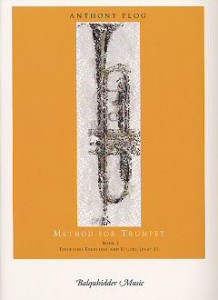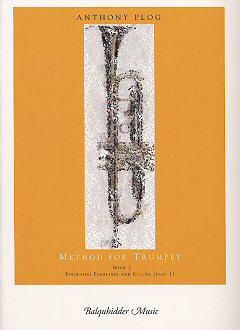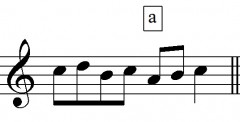Anthony Plog’s “fingering exercises and etudes” from his Method for Trumpet (see below) make for fun practicing. This week we’ll take a look at Vol. 2, Ex. 7:
At sixteen measures, this is on the longer side for a scale pattern. How are we going to memorize it? With two techniques. The first is already in this article’s title: “Divide and Conquer.”
On your first play-through, you might notice that this exercise consists of the same four-bar pattern, repeated a step higher each time. (It’s a “tonal transposition”, i.e. one without accidentals). So let’s break the exercise up and memorize the first line by itself – after that we can just repeat the pattern three times.
 Now that we’re focusing on the first line alone, we’re going to employ a technique called “chunking.” By grouping bits of information together, we make it easier to remember and digest the information in front of us. In this case, instead of trying to memorize every single note, we’re going to group all the notes of mm. 1-4 into five events. If you’re trying to memorize something, keep “Miller’s Law” in mind: you only have room in your head for about seven bits of information at a time (plus or minus two).
Now that we’re focusing on the first line alone, we’re going to employ a technique called “chunking.” By grouping bits of information together, we make it easier to remember and digest the information in front of us. In this case, instead of trying to memorize every single note, we’re going to group all the notes of mm. 1-4 into five events. If you’re trying to memorize something, keep “Miller’s Law” in mind: you only have room in your head for about seven bits of information at a time (plus or minus two).
Event A: tonic triad (up and down)
Event B: five note scale (going into the next downbeat)
Event C: events A and B up a fifth
Event D: descending scale pattern: up a step, down a third
Event E: a little melodic pattern to get ready for the next line…
These patterns are easy to see and hear, but it’s useful to be able to describe them precisely in words (teachers: it’s also a fun way to stump your students).
Now, we just repeat Events A-E starting on scale degree two instead of one. Of course, knowing your triads cold is a huge help – especially knowing what kind of triad you will play for each scale degree (I = major, ii = minor, etc.).
The last event is the very end of the study. Often composers will change a pattern slightly so we land nicely on “do” at the end, and the last bar of this exercise is no exception:
You can see we don’t even need to think about the entire last bar, just the last two beats.
With practice this approach becomes second nature, and you can abandon the incredibly boring and unreliable process of memorization by repetition. Happy practicing!

This week’s exercise comes from Anthony Plog’s Method for Trumpet. This seven-volume monster has been around for just over ten years. It’s an interesting addition to the world of trumpet: very short on text but rich in compositional ideas. Volume 2, our source this week, is typical: three pages of introductory text followed by about fifty pages of exercises. Unfortunately, this method lists every exercise in all possible keys – the thirteen exercises of Vol. 2 would probably fit on six pages.



